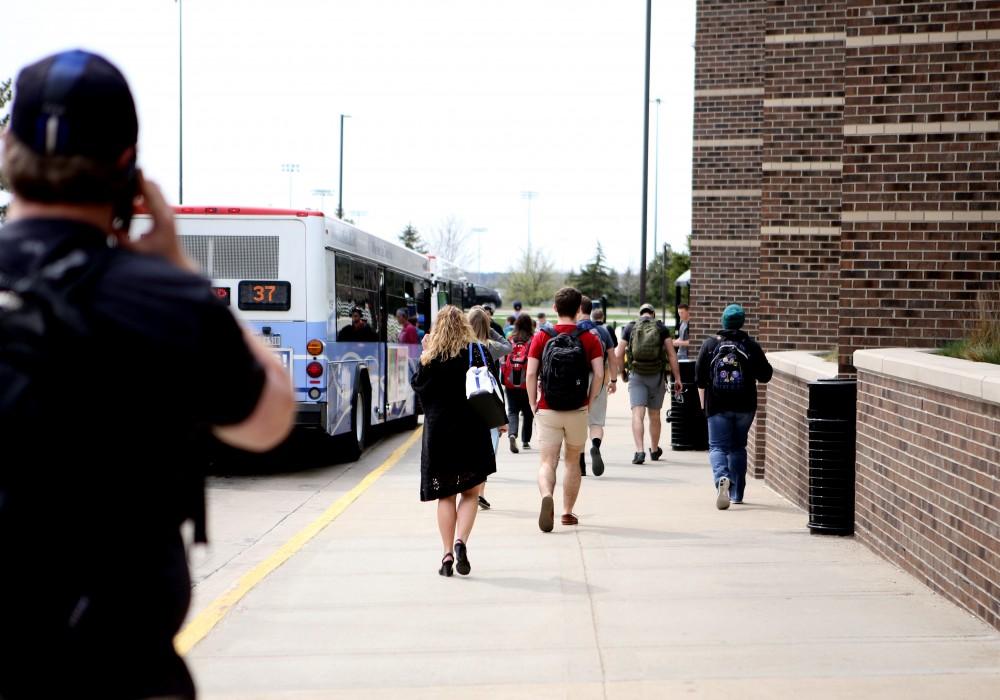Laker Line project asks for student feedback

GVL / Emily Frye The Rapid on April 20, 2016.
Apr 21, 2016
On April 20, representatives of the newly redesigned Laker Line held an event open to all students to introduce Grand Valley State University’s fresh concept for busing.
Busing is a very important part of many student’s lives at GVSU. The Route 50 is responsible for getting students between the Allendale and Pew campuses each and every day. However, the Federal Transit Administration has recommended that the Laker Line be added into the 2017 federal budget.
The budget required for the new bus line totals $71 million. However, the federal and state government is footing the bill after research dating back to 2013 has shown just how useful this change will be. GVSU’s Route 50 experienced a growth rate of 693% from 2002-12, according to the Laker Line study.
The introduction of the Laker Line into the federal budget will allow for more money to be allocated into the busing program, transforming it into a bus rapid transit (BRT) instead. With the increased budget, the team working to improve the Laker Line hopes to completely revitalize the way students are traveling.
The new BRT buses will operate like trains, but for a fraction of the cost. Stations will now have arrival information, emergency phones and security cameras in the stations. Buses will now come standard with Wi-Fi and traffic signal priority, reducing travel times. They will also be larger in size, allowing for 90 passengers at one time.
The proposed route will total 13 miles and connect the Kirkhof Center, a hub for many students, to the GVSU Cook-DeVos Center for Health Sciences. There are 14 different stations planned to be built along this line for various strategic purposes.
Construction on this new line is anticipated to begin in 2017, with it being available to students in the spring or summer of 2018. However, the project team is still hoping to get students’ opinions to truly perfect their design, which is why they held the Laker Line pop-up transit plaza.
The event took place under the US-131 underpass at Mt. Vernon and Fulton, because that station location has some of the highest ridership on the system, according to Lynee Wells, principal and urban planner with William & Works.
The goal of this event was to gather information from those who know the GVSU busing system best, the students. Those in charge of creating the new Laker Line wanted assistance in personalizing the amenities for each station to best fit the surrounding neighborhood.
Students were asked to fill out surveys in regard to pedestrian safety. They were also given an example of a possible new mid-block crosswalk that could be built by the Fred M. Keller Engineering Lab.
Designers were also curious as to preferences for a specific type of underpass activation. These activations deal with the design of the US-131 underpass and include five options with pictures: play, light, multi-use, green and art. This particular question was interactive, allowing participants to place a sticker in the category of their choosing after examining all of the options.
“It’s a great way to create two-way communication with the affected populations and we’re able to educate people on the project itself,” said Nicholas Govann, a member of the Urban Planning Association at GVSU.
The event tempted students to stop by with the addition of free corn dogs, sliders and fries from food trucks. Corn hole, hammocks and Jenga were also laid out for anyone looking to have some fun.
Ultimately, any feedback given by those using the busing system was considered good feedback for the designers as they try to provide a new and improved service to the GVSU students of the future. For more information or to contact the Laker Line, visit www.lakerline.org.






















